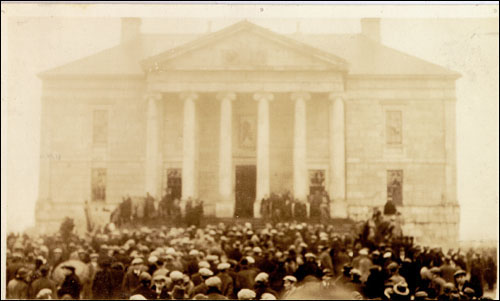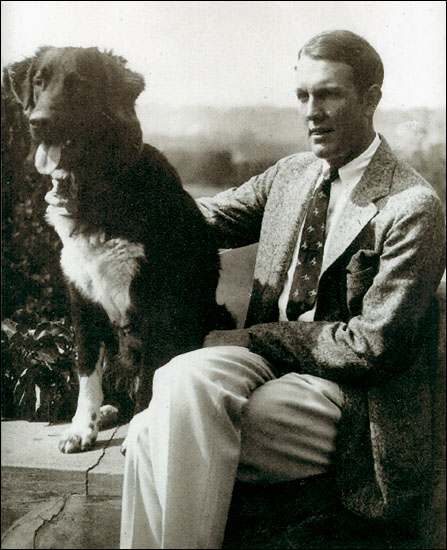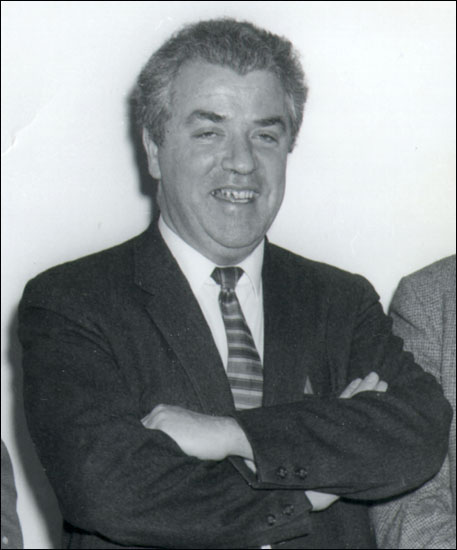Early Days of Film
Newfoundland's first cinema was The Nickel, which opened in St. John's in 1907. Within a few years movie houses were operating all over the island and people were lining up to see the latest adventures and romances from Hollywood.
Early Newfoundland Filmmakers
The earliest Newfoundland filmmakers were hobbyists using cameras to record local events, family outings, scenery and travels. The first of them may have been Eric Bowring and Judge Harry Winter, a pair of St. John's men who began collecting footage in 1904. The work of another amateur cameraman, John Munn, includes a protest at the Colonial Building in 1932 and scenes from Amelia Earhart's visit to Harbour Grace. One of the few early photographers to see his footage turned into a finished film was a missionary named Monsignor O'Brien. He first came to Labrador in 1928 and continued to visit regularly for the next 20 years, always accompanied by his film camera. In 1979 O'Brien worked with the Memorial University Extension Service to assemble his footage from Davis Inlet and Northwest River into a film called The Indians' Father Whitehead.

But in the first half of the 20th century, films of Newfoundland and Labrador were usually created by outsiders: Producers and directors arriving with film crews from Canada, Great Britain or the United States. The earliest silent movies associated with the island are Moose Hunting In Newfoundland (1905) by the American Mutoscope and Biographical Company and Stalking And Shooting Caribou In Newfoundland (1907) by the Edison Company, though there is evidence to suggest the moose hunting film may have been done elsewhere and subsequently mislabelled. Other companies followed, and for the next 20 years most of the movies shot in Newfoundland were travelogues designed to promote the island and Labrador as hunting and fishing destinations.
First Hollywood-Style Sound Film
In 1922 an American named Varick Frissell arrived in Labrador as a volunteer with the Grenfell Mission. Frissell worked with the mission for several years, often shooting film of his travels throughout the region. He completed three documentaries about Labrador, including The Great Arctic Seal Hunt (1928).
Frissell's fascination with the seal hunt lead him to create the first Hollywood-style sound film ever made in what is now Canada. Frissell wrote a screenplay about two sealers, their rivalry for a woman's love and their adventures on the seal hunt. He formed a company to finance the project and generated interest from several distributors. With a cast of New York actors and an American film crew, Frissell filmed most of The Viking (named for a sealing ship) in Quidi Vidi in 1930. Determined to supplement the story with images showing "the hardihood, skill and courage of the Newfoundland seal hunt," Frissell then took his crew to the Grand Banks and Labrador to collect realistic footage and do the more exciting action sequences.
The Viking debuted with a private showing at the Nickel in March of 1931. Frissell came away convinced that his movie needed more real scenes from the Labrador ice flows. He assembled another small film crew and within days had joined the real Viking for its annual seal hunting voyage. On March 15, as the Viking sat trapped in ice near the Horse Isles, an explosion in the powder room destroyed the back of the ship and killed 27 men. Frissell's body was never found. That summer The Viking was released in Toronto, New York, London and Paris.

49th Parallel and Island Story
For the next 40 years dramatic films would be rare and unusual occurrences in Newfoundland. In 1941 the British Ministry of Information sent a crew to Canada to make a film called 49th Parallel as part of its wartime propaganda campaign. It included a special effects scene in which a German submarine actually a plywood structure fitted with dynamite and gunpowder was exploded in waters near Corner Brook. In 1946 the Newfoundland Commission of Government paid a British company $200,000 to profile the island and its way of life through a drama called Island Story. Cast with local actors and filmed in St. John's, it was released in 1949. St. John's audiences were unimpressed and the film was ultimately seen by few inside or outside the province.
Documentaries
But documentary-making increased steadily during the war years and the decades that followed. The National Film Board of Canada first came to the island in 1940 to make Toilers Of The Grand Banks, a nine-minute film about fishermen. The war effort and the Newfoundland lifestyle were the subjects of several other short NFB films in the pre-Confederation years. After 1949 films about Newfoundland and Labrador fell under the NFB's mandate ("...to help Canadians in all parts of Canada to understand the ways of living and the problems of Canadians in other parts.") and production increased accordingly. During the 1950s and 1960s the board produced over 50 short films and vignettes in the province.
Independent Filmmakers
Meanwhile, Newfoundlanders were stepping behind the camera more frequently. W.J. Ryan of St. John's made a silent film of the 1946 Victory Day parade and documented several other events. Other independent filmmakers included Lionel Burry in Labrador and Len Earle of St. John's, who made travel films at home and abroad under the sponsorship of Harvey's Travel. In 1959 the Memorial University Extension Service created a "media unit" with the intention of filming lectures and other information-based films for distribution around the province. This idea eventually evolved into a television program called Deck's Awash. But by the 1960s, the Extension Service had broadened the scope of its film work. The media unit produced short documentaries on all aspects of life in the province. It also recorded news conferences, meetings, debates and public events. A scan through its catalogue reveals films about seal pelt quality, bookkeeping, school concerts, teenage sexuality and everything in between.

The Extension Service also cooperated with the National Film Board on several ventures, most notably the "Newfoundland project." In 1967, the NFB sent a crew to Fogo Island to make a one- hour documentary, with the help of field workers from MUN Extension. People in the community were invited to help set the agenda for the film and participate in the production and editing process. The one-hour documentary was eventually scrapped in favour of a series of short films done over a two-year period. The Fogo Island series ultimately became as much a product of the community itself as that of a visiting film crew. The exercise was used for several other NFB projects, including an eight-hour documentary made in Port au Choix.
Provincial Government Films
The provincial government began making films in the 1950s and 1960s. Most Newfoundland communities were still without television, so promotional and educational films that could be shown in theatres were seen as important tools for reaching the people. Most of the films provided practical information or celebrated various government programs. They were also used to promote the province to outsiders. The hunting and fishing films of American naturalist Lee Wulff, who had been visiting and filming in the Newfoundland wilderness since the 1930s, were perhaps the most popular government-sponsored films of this era.
NIFCO
By the late 1960s young independent filmmakers were dabbling in the medium for the first time. Mike Jones was a teacher at Brother Rice High School when he made his first silent films. David Pope did a series of silent shorts while studying at Memorial University. John Doyle studied film in Toronto. Derek Norman was working with MUN Extension. They were among the first members of the Newfoundland Independent Filmmaker's Cooperative, which was formed in 1975.
NIFCO began with 14 charter members (13 men and one woman) and a small cache of used and borrowed equipment provided by MUN Extension. The Extension service also gave NIFCO $7,000 and the NFB donated office space at its building in Pleasantville. Operating money from the Canada Council and the NFB helped sustain NIFCO in the early years as filmmakers volunteered on each other's films and obtained small grants for their individual projects. The first generation of NIFCO members laid the groundwork for the contemporary Newfoundland film industry and gave the province its first significant library of independently produced documentaries and short films. Most of the early members of the co-op remain active in the industry today.
Archived Film
Though much of the early film shot in Newfoundland and Labrador was lost or destroyed, a valuable and significant archive has been preserved. The Provincial Archives includes footage by pre-Confederation filmmakers like John Munn, Varick Frissell's The Viking and The Great Arctic Seal Hunt, and many government films from the 1950s and 1960s. Memorial University, NIFCO, the National Film Board and the public library system maintain rich collections of much of the work done since Confederation.




